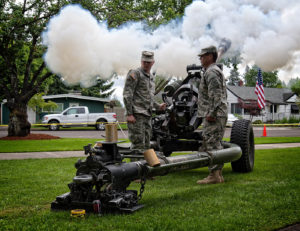Perception, Choice, Recovery
I recently read an article and watched a few videos posted by Awareness Act on a study called the Delayed Choice Thought Experiment (you can see the article and videos here). And while the study is too complicated for me to fully explain here, the underlying principle is that from a quantum physics perspective, reality (including the past) is completely based upon how we perceive it.
The short – and simplified (for my sake, not yours) – explanation of the procedure was that the researchers first shot photons (very tiny particles) at a barrier with one slit that allowed some of the photons through. They then shot photons at a barrier with two parallel vertical slits. The results are amazingly confusing. The behavior of the photons – as measured by the resulting pattern made by the photons shot through the slit(s) – vary based upon what the researchers knew. For example, if the researchers placed a camera next to “slit 1” so it could see when a photon went through it, the resulting pattern was two parallel columns of photons. However, when they took that camera away, the behavior of the photons change completely. Instead of acting like a single particle, they acted like a wave.
OK, I know that sounds confusing. Go back and watch the video from Awareness Act and then come back. It is fascinating!
What Does Quantum Physics Have to do with Me?
What that really complicated, yet amazing study teaches us is that our reality, including what happened in our past, is all based upon our perception. Imagine being able to actually change what happened in the past simply by changing the way we perceive it. And I am not just talking about changing how we remember events through something like repression. No, actually changing what happened.
Unlike this quantum physics experiment, though, there are limitations to how we can actually “change” the past. After all, once the scar has been observed, events have already occurred in such a way as to result in that scar. You cannot change that. However, can we change our understanding of past events, thereby changing how we perceive it?
It sounds unbelievable, but it is a principle that we already use, or at least try to use. When something bad happens in our life, we often try to “reframe” it so that we can learn and/or benefit from it. That is the nature of self-growth. Taking a negative, learning from it, and becoming a better person.
PTSD, CBT, and EMDR
Yesterday we celebrated Memorial Day, the day we honor those brave men and women who put on the uniforms of our armed forces and went to battle to protect our freedoms. And while we honor those who passed, we also celebrate those who continue to volunteer for a job most of us could not imagine.
While many of those in the military – those currently enlisted and those who have retired – talk about the bonds and relationships built with their “brothers in arms,” many return from deployment with psychological damage. The prevalence of PTSD (Posttraumatic Stress Disorder) in the military is ever increasing. The government estimates that 11-20% of veterans from Operation Iraqi Freedom and Enduring Freedom experience symptoms of PTSD in any given year (read the VA.gov article here).
For those with PTSD and seek therapy, CBT (Cognitive Behavioral Therapy) has become the primary treatment modality. The goal of CBT is to help adjust thoughts and perspectives of the trauma that the veterans (or anyone with PTSD) experienced. One way CBT is helpful is by finding ways to identify triggers in the environment. As anyone with PTSD knows, triggers can come out of nowhere and result in impairing psychological (thoughts and emotions) and physiological (stress, fear, or aggression) responses. Triggers are current stimuli that elicit the feelings and thoughts of the traumatic experience. Once the triggers are identified, strategies can be developed to learn how to avoid and calm those reactions. In essence, CBT works to change and restructure how those with PTSD experience thoughts and memories from the past.
Another effective treatment for PTSD is a newer process called EMDR (Eye Movement Desensitization and Reprocessing). EMDR activates the brain through bilateral stimulation while the patient is discussing or imagining the traumatic event. Now that is a very simplified explanation, but results are very promising and the use of EMDR is rapidly growing. Again, though, the goal is to change how the mind and body respond to our memories of the traumatic experience.
While CBT and EMDR do not actually change the past of those with PTSD, they do offer a restructuring and reprocessing of the events that caused the PTSD symptoms. Through treatment, many find relief and can return to a happy and healthy life — the kind of life they fought and sacrificed themselves for.
Thank you to all of the veterans out there who have, are, and will put themselves on the front line to protect our way of life and to improve the lives of others. We are forever indebted to you and your families.

About the author